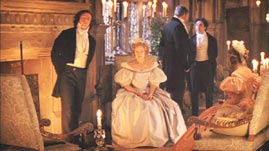Teachers' Domain - Digital Media for the Classroom and Professional Development
User: Preview


Source: MASTERPIECE: "Jane Eyre"


MASTERPIECE is funded by Viking River Cruises, with additional support from public television viewers, and contributors to The Masterpiece Trust, created to help ensure the series’ future.
In this scene from the 2007 MASTERPIECE film of Jane Eyre, Jane has been invited to bring Adele to the ladies at a fancy dress party, including the imperious Lady Ingram and her beautiful daughter Blanche, whom everyone assumes will become Mr. Rochester’s fiancée. As the scene opens, Mr. Rochester and Lady Ingram are arguing. “If some people are rich and some poor, then that is God’s will. So be it, I am satisfied,” she tells Mr. Rochester. Blanche is annoyed and unfriendly towards Adele and, when the conversation turns to governesses, her mother declares, “…governesses are a nuisance, all of them.” Blanche laughs carelessly about a trick she played on one of her governess. “We were very naughty,” she says, “She was so boring, poor thing.” Jane observes the conversation silently, but she is hurt and insulted by their disdain and disgust.
Charlotte Brontë: Biography (Document)
The governess is a familiar character in novels and films. Becky Sharp, in William Makepeace Thackeray’s Vanity Fair (1848), is a governess. The protagonist in Henry James’s The Turn of the Screw (1898) is one as well, as is the ghostly apparition that appears in the film. In Jane Austen’s Emma (1815), the character Jane Fairfax is “condemned” to be a governess, but is saved by becoming engaged. In 1965, Julie Andrews won an Academy Award portraying the governess Maria in The Sound of Music.
Charlotte, Anne, and Emily all spent time employed as governesses—an experience none of them enjoyed. They disliked the lack of respect from their employers, the low wages, and the unceasing demands of the job. Jane Eyre is not the only novel written by a Brontë to feature a governess; Anne Brontë’s Agnes Grey is a realistic portrait of the problems governesses encountered.
In Jane Eyre, Mr. Brocklehurst, the proprietor of Lowood School, describes the goals of his institution: “...my plan in bringing up these girls is, not to accustom them to habits of luxury and indulgence, but to render them hardy, patient, self-denying...” Hardiness, patience, and self-denial were all traits that would serve the future governess in Victorian times well. Neither family member nor downstairs servant, the governess held a peculiar and ill-defined role in Victorian society, which found middle-class female employment anxiety-producing. An unmarried woman, and particularly one who had to work, was considered an aberration.
In 1850, there were an estimated 21,000 governesses in England. Despite the negatives, there were more applicants than there were positions—the only alternatives being marriage, domestic service, prostitution, or the poorhouse. The numbers of job seekers kept wages very low. A governess would typically receive room and board, but was expected to provide for her own laundry, travel, and medical care. Appropriate dress was also required but not subsidized. Provisions for unemployment and old age were also completely the responsibility of the governess.
The inherently contradictory nature of her role meant that, in the midst of a bustling household, a governess was often alone and lonely. The disparaging remarks about governesses by Lady Ingram and her daughter, Blanche, overheard by the good-hearted and innocent Jane, in Jane Eyre, reflect Charlotte Brontë’s real-life experiences and reveal the injustices of the institution.
The lack of humanity on the part of the upper classes is keenly revealed in this scene, both in their notion of poverty and in their treatment of their servants. Charlotte Brontë experienced this uncaring and cruel attitude in her own life, as a charity student and as a governess herself. Typically underpaid, governesses didn’t quite fit upstairs or downstairs, and were often lonely and unhappy. Yet for an unmarried woman there were few alternatives for employment in the 19th century. As students examine the scene, they explore the realities about women’s roles in the Victorian era.
Before watching the video:
While watching the video:
After watching the video:
For more about how to use MASTERPIECE in your classroom, see the MASTERPIECE Teacher’s Guides where you will find the guide, Film in the Classroom, Revised. You might also want to use the resources available in the Jane Eyre Book & Film Club.
 Loading Standards
Loading Standards